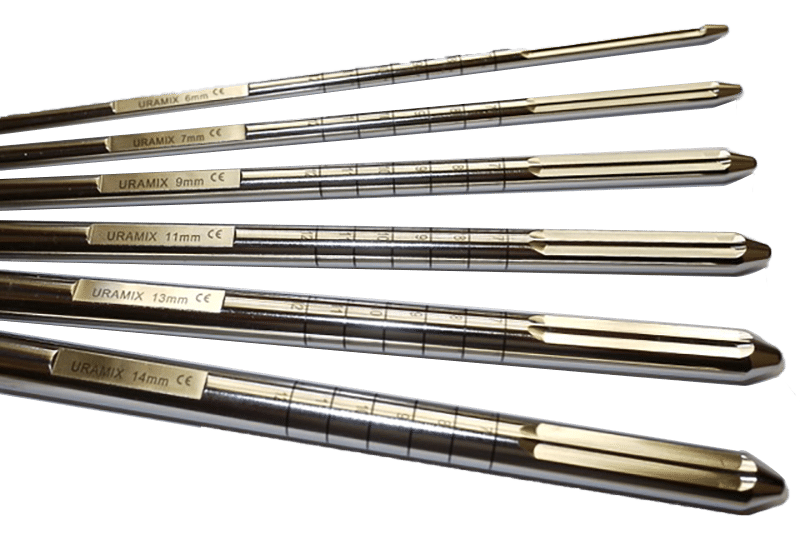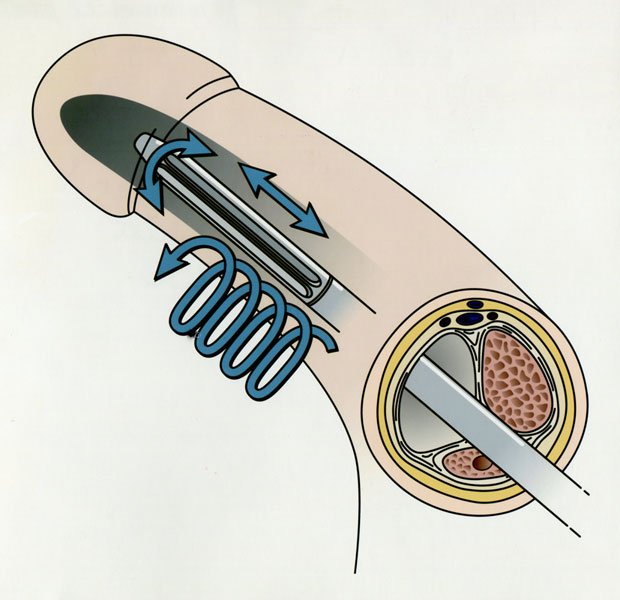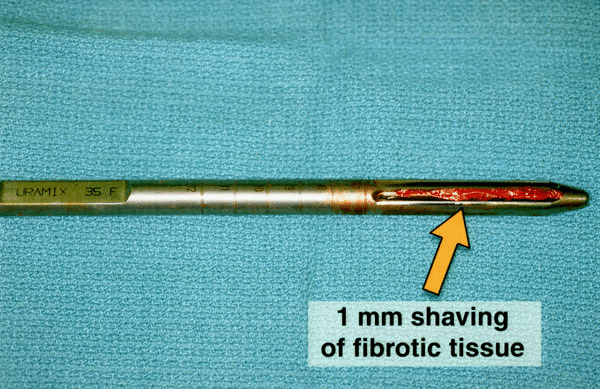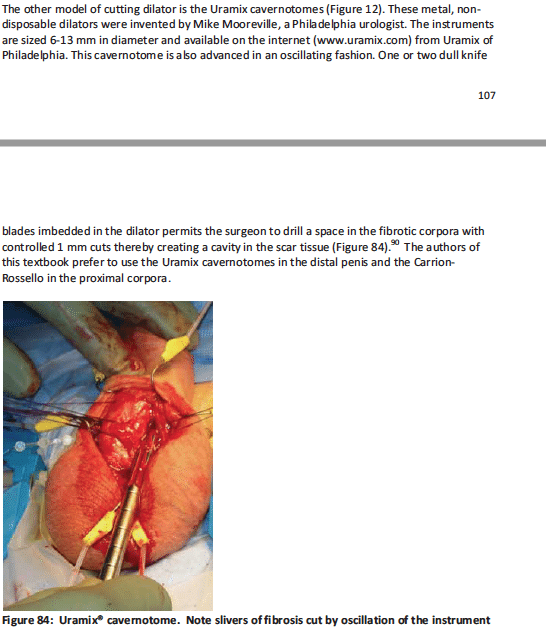

The Mooreville Dilator
Single-Bladed Cavernotome
The cavernotome has a simple, yet ingenious design, which helps the surgeon control the cutting and shaving action of the dilator within the confines of the corpora. The cavernotome incorporates a 1 mm cutting blade, which rises from a beveled surface within the circumference of the dilator and does not exceed this perimeter, for a precise and controlled cut or shaving action.
HAVE QUESTIONS?
Dr. Mooreville is available to answer by email or a telephone conversation can be scheduled.
REACH OUT TODAY
uramix@comcast.net
+1 610.394.9850
Key Benefits
Cuts and Shaves Fibrotic Tissue
Peronie’s disease, sickle cell, priapism, prolonged intracavernosal therapy, redos, subcapsular space creation in eroded prosthesis
Improves and Shortens the Dilation Process
Avoids multiple corporatomies
Avoids false passages
Controls the Depth of the Internal Cut by its Design
Represents a significant improvement over existing instruments
Play Video
Method of Use
The Mooreville Dilators were designed for use in both moderately fibrotic corporas as well as virgin implants.
- Entry to the fibrotic corpora needs to be accessed by scalpel and extended both proximally and distally to allow entry to the cavernotome
- The working element should be directed laterally initially
- If tissue does not respond to the cutting process the cavernotome can be rotated or moved in an oscillating fashion to create a shaving action that removes fibrotic tissue and at the same time propels the cavernotome forward
- The cavernotomes are used in succession until the desired size is attained
- Can be used in normal corpora for a speedier dilation
- Can be used as a measuring tool
Method of Use
The Mooreville Dilators were designed for use in both moderately fibrotic corporas as well as virgin implants.
- Entry to the fibrotic corpora needs to be accessed by scalpel and extended both proximally and distally to allow entry to the cavernotome
- The working element should be directed laterally initially
- If tissue does not respond to the cutting process the cavernotome can be rotated or moved in an oscillating fashion to create a shaving action that removes fibrotic tissue and at the same time propels the cavernotome forward
- The cavernotomes are used in succession until the desired size is attained
- Can be used in normal corpora for a speedier dilation
- Can be used as a measuring tool
Play Video
Features Overview
High Quality Material
Top grade surgical steel
Long-lasting
Can be resterilized
The Set
5 cavernotomes with diameters between 6, 7, 9, 11, and 13 mm
graded in centimeters
Cavernotomes can also be used as a measuring tool
Working element
6 cm long, and starts 1 cm from the tip
Length
23 cm
Easy to Discern Blade Orientation
A 4 cm flat beveled surface is placed about 7 cm from the cutting element on the same plane as the beveled surface of the blade to let the operator know how the cavernotome is oriented, if the blade is buried and not visible
Tapered head
1 cm long, protects ends of the corpora
Blade Height
1 mm and does not exceed the circumference of the cavernotome to avoid cutting beyond this perimeter
Includes
EVA cases, combining the protection of a hard case with the versatility and portability of a soft case
Pricing
$2,499 for all five (6mm, 7mm, 9mm, 11mm, 13mm)
$2,859 for Dilator Set + 14mm dilator
$595 for 14mm dilator
SKU # 9901
Patent # 5,968,067

Case study
The cavernotomes were used in nineteen patients with corporeal fibrosis. The etiology of the fibrosis was removal of previously infected prosthesis (15), extensive fibrosis from recurrent priapism secondary to sickle cell disease (2), pharmacologic injection program and subsequent Winter shunts (2). One of the patients whose prosthesis was removed for infection also had a tip erosion on the contralateral side necessitating the creation of a subcapsular space for the insertion of a new cylinder.
Surgical Technique
After a small corporotomy is created, the cavernotomes are introduced and moved in an oscillating motion resulting in forward advancement. If more resection is needed, rotation of the cavernotomes will create a “shaving” action which removes 1 mm strips of fibrotic tissue.
- Cutting can be done both in a longitudinal, up and down, movement, or in a “drilling” rotational movement.
- The largest size (13 mm) corresponds to standard cylinder diameter. Dilation to 10 mm is necessary for insertion of the Furlow tool or the Mentor NB cylinder base. Dilation to 11 mm is necessary for the insertion of the AMS CXM base.
- Internal cutting of the fibrosis obviates extensive corporotomies and results in quicker procedures.
- The cavernotome’s design and oscillating advancement promote safe dilation without perforation.

Cavernotome being used to dilate fibrotic corpora
All uses of the cavernotomes resulted in successful implantation of inflatable cylinders or semimalleable rods without urethral injury or corporal perforation.
- Fifteen of the patients received downsized prosthesis (13 Alpha NB, 2 AMS 700 CXM).
- Of the remaining four patients, three patients were implanted with Mentor Alpha 1 standard size cylinders, and 1 patient was implanted with an AMS semimalleable prosthesis.
- Graft material was not required and only two patients required additional distal penile incisions for optimum cylinder tip placement.
- Average operative time was 51 minutes (39-86 minutes range).

As seen in Wilson’s Perils and Pitfalls of Penile Prosthesis Surgery, Tobias S. Kohler, MD, Nikhil Gupta, MD, Steven K. Wilson, MD, 2nd edition, January 2018
references
Bruce B. Garber, Caitlin Lim. “Inflatable Penile Prosthesis Insertion in Men with Severe Intracorporal Fibrosis.” Current Urology (2017) 10:92–96.
Michael Mooreville, Sorin Adrian, John R. Delk, and Steven K. Wilson. “Implantation of Inflatable Penile Prosthesis in Patients with Severe Corporeal Fibrosis: Introduction of a New Penile Cavernotome.” The Journal of Urology 162 (1999).
Steve K. Wilson. “Reimplantation of inflatable penile prosthesis into scarred corporeal bodies”. International Journal of Impotence Research (2003) 15, Suppl 5, S125-S128.
place an order
Fill out the information required and we will be in touch to continue the order process.